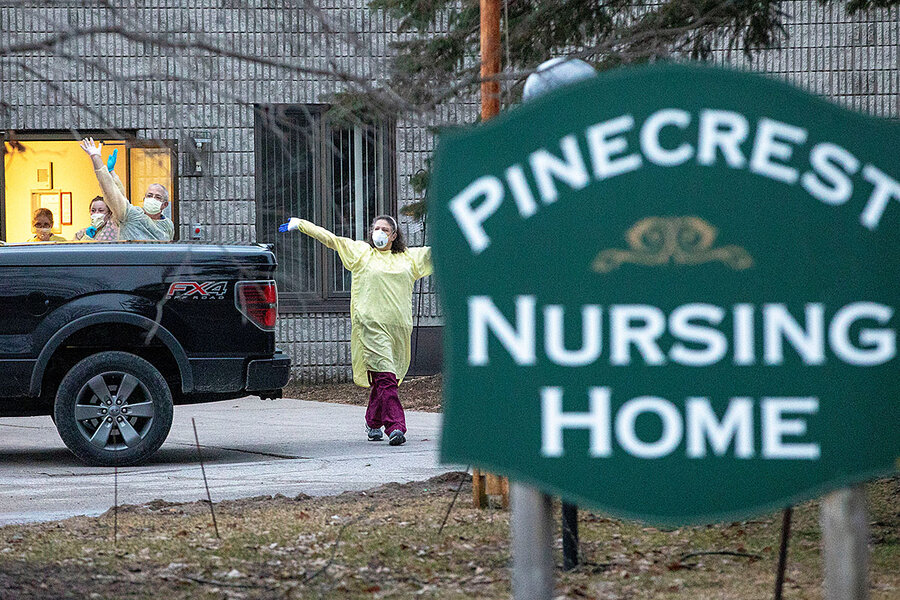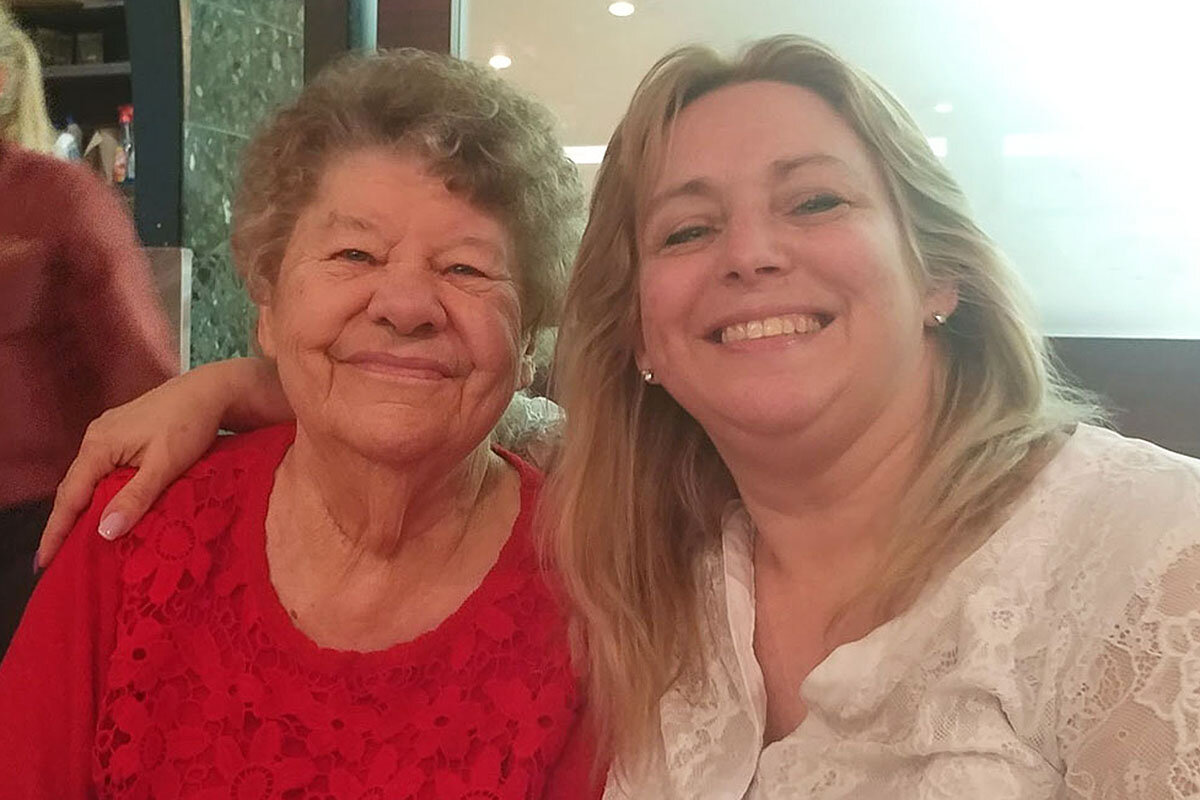‘They didn’t get to die with dignity’: Canada reexamines care for seniors
| Toronto and Montreal
France Brideau checks her phone each morning when she wakes up to see if her mother has called. But it’s just a reflex, a realization that hits heavily each day: Her mother, Thérèse Duguay, died in mid-April from COVID-19.
“It’s strong, that bond,” Ms. Brideau says in a telephone interview from her home in Laval, a city in the Canadian province of Quebec. “She was there for me for 56 years.”
Ms. Duguay contracted the novel coronavirus in a long-term facility, where she moved in February 2019 after her care at home got too complicated. A year later, that move unwittingly placed her in the heart of a pandemic. In Quebec, which has seen the highest coronavirus infection and mortality rates in Canada, 63% of COVID-19 fatalities have occurred in long-term care facilities, known as CHSLDs.
Why We Wrote This
COVID-19 has tested the effectiveness of safety nets. The alarming concerns about nursing homes that have surfaced in Canada, a country known for its health coverage, are spurring a national reexamination.
Per capita, Canada has fared much better than the United States in containing the spread of the disease. But although both countries have suffered outbreaks in nursing homes, that problem has been much more severe in Canada: More than 80% of COVID-19 fatalities in the country are linked to them, according to Theresa Tam, Canada’s chief public health officer.
Editor’s note: As a public service, all our coronavirus coverage is free. No paywall.
Canada is not alone in confronting a high mortality rate among older people, especially those in institutional care. But in a country lauded for its universal health protections, the death rate and shocking conditions in some homes have generated an urgent conversation about whether its safety net is supporting those most vulnerable.
In Quebec and Ontario, the military has been deployed to assist nursing facilities that have been hardest hit. This week the Canadian Armed Forces shook the nation with a damning report on the unsafe state of five long-term care facilities in Greater Toronto. Ontario Premier Doug Ford promised justice, calling the findings “heartbreaking” and “gut-wrenching.”
Advocates and victims’ families are calling for public inquiries as to what went wrong and for new national standards for long-term care to be established. They want emergency measures that were implemented to contain the outbreaks – such as better wages for personal support workers so they don’t have to patch together part-time work to make ends meet – to become permanent. Some want the entire industry to be rethought.
“We’ve been able to kind of eke along with minimal staffing levels in nursing homes, but COVID has blown it apart. It’s shown it just wasn’t sustainable,” says John Hirdes, a professor at the School of Public Health and Health Systems at the University of Waterloo in Ontario. “This has focused everybody’s attention that we really need to put in an effort to change the nature of how we provide nursing home services in the country.”
The Canadian setup for health care
The principles behind Canada’s publicly funded health system, which requires that all medically necessary hospital and doctor services be covered, does not extend to nursing or home care. While all the provinces and territories provide some coverage for such care, run by a mix of public and for-profit entities, it varies extensively, says Paul Williams, a University of Toronto professor and co-chair of the Canadian Research Network for Care in the Community. “I think it was massively shocking to people to find out what was going on in places which are understaffed and underfunded,” he says.
It’s not shocking to advocates, though. Paul Brunet, who heads a patients’ rights group that launched a class-action lawsuit in 2018 on behalf of Quebec’s CHSLD patients, says understaffing and a lack of funding have meant for years that patients have not received the care they are entitled to under the law. In Canada, “everyone has access to all the care he or she might need, but when there’s budget cuts ... unfortunately the poorest and the oldest normally [take the hit],” he says. “To me, it is discrimination. It is prejudice.”
And many believe it set the country up for failure when the pandemic swept through. In one of the most notorious cases, residents in a privately owned CHSLD in Montreal were left abandoned without water and in full diapers for days, the Montreal Gazette reported. At least 51 residents died as a result of the outbreak, which is now the subject of three inquiries.
Quebec Premier François Legault has acknowledged the problem, saying that “society failed” to protect those most vulnerable and that successive governments did not invest enough in the CHSLDs. “I think that many people are responsible. I don’t exclude myself,” Mr. Legault told reporters.
In Ontario, Mr. Ford, under fire for turning a blind eye to the problem before the pandemic, said he’d launch an independent commission to probe the failings, in which around 1,500 nursing home residents have died from COVID-19 (among more than 2,100 in total). An investigation by the Toronto Star showed that seniors in for-profit care are four times as likely to die as those in public facilities.
According to Sharleen Stewart, president of the Service Employees International Union Healthcare that represents 60,000 front-line health workers in Ontario, low staffing levels – while populations have grown older and more clinically complex over the past two decades – have left the system dangerously exposed. One key reason for COVID-19’s rapid spread: Personal support workers in nursing facilities, paid far less than their counterparts in hospitals, have to work in multiple facilities, she says.
“Early on in March, when the government was calling us together to talk about a pandemic plan, I asked the question: What are we going to do about the fact that 1 in 3 personal support workers work more than one job?” She says she was ignored. “Somebody needs to be accountable for this.”
One way forward?
No outbreak is “inevitable,” argues Michael Schwandt, a medical health officer in the Vancouver Coastal Health system in British Columbia. At present the system has managed 14 outbreaks by implementing measures including constant testing and containment and proper use of protective equipment. The system has declared eight of those outbreaks over. He says more permanent changes, such as staff earning a living wage at a single center and being able to take off work when sick, would both limit the spread of disease and provide better continuity of care for residents.
“I have a lot of hope,” he says. “I think that we’ve seen some improvements put in place in short order in [British Columbia] to limit the impacts of the pandemic, and with some of those successes, I hope that some of those measures will be made permanent and will spread to other [places] as well.”
Dr. Hirdes foresees a growing discussion in the country about extending the concept of the Canada Health Act to nursing homes and home care, although how that would be achieved is unclear. As a start, Dr. Williams says that Canadians would welcome national standards, but he’d like the process to lead to an overhaul of the industry – finding more ways that seniors can stay in their communities, and not just increasing funding for institutional settings.
“I hope they take this as an opportunity to rethink, as many other countries have, the entire idea of care over the longer term instead of long-term care beds,” he says.
For now, many like Ms. Brideau are left wondering if they’d still have their loved ones if the system had implemented changes earlier. On April 12, just a week after her mother tested positive, Ms. Brideau says she got a phone call from the CHSLD telling her that her mother’s condition had deteriorated and that she should come in.
Ms. Duguay died that afternoon. “When I hear anything about COVID-19 now, my eyes fill up with tears and my throat tightens,” Ms. Brideau says. “They didn’t get to die with dignity. ... I’m really disappointed in society, disappointed in everything that is happening.”
Editor’s note: As a public service, all our coronavirus coverage is free. No paywall.






